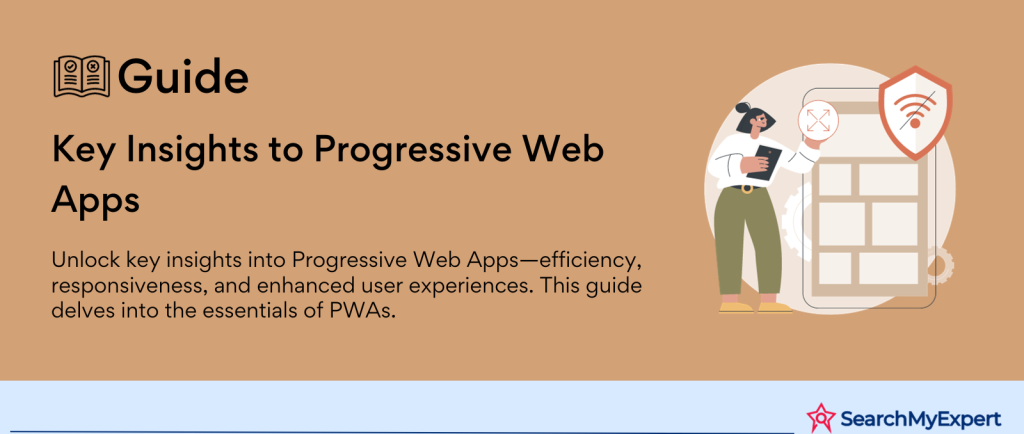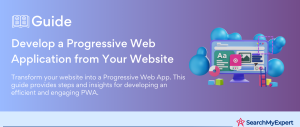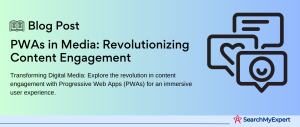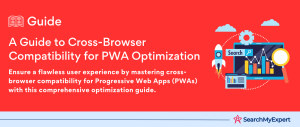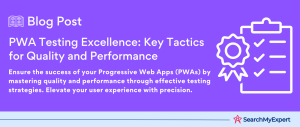Progressive Web Apps (PWAs): The Future of Web Applications
In the ever-evolving landscape of web development, Progressive Web Apps (PWAs) have emerged as a groundbreaking solution, redefining user experience on the web. At their core, PWAs blend the best of web and mobile apps to offer a seamless, high-performance user experience. This introduction aims to unravel the essence of PWAs and spotlight their myriad benefits.
Understanding Progressive Web Apps: A Blend of Web and Mobile Excellence
A Progressive Web App is more than just a website; it’s a hybrid that combines the accessibility of a web page with the functionality of a mobile app. Built using common web technologies like HTML, CSS, and JavaScript, PWAs operate in a browser, yet offer an experience indistinguishable from native mobile apps. What sets PWAs apart is their ability to leverage modern web capabilities to deliver a fast, engaging, and reliable user experience.
Key Benefits of Progressive Web Apps
- Offline Access: One of the hallmark features of PWAs is their ability to work offline or on low-quality networks. Thanks to service workers, a core technology behind PWAs, users can access content without an internet connection, thus ensuring uninterrupted usage.
- Fast Loading Times: Speed is a critical factor in user experience. PWAs are designed to be exceptionally speedy, even in uncertain network conditions. They utilize strategies like caching and lazy loading to ensure that content is delivered quickly and efficiently.
- App-Like Experience: PWAs mimic the feel and navigation of a native app, offering features such as push notifications, home screen icons, full-screen mode, and gesture navigation. This app-like experience enhances user engagement without the need to download an app from a store.
- Responsive and Cross-Platform Compatibility:
PWAs are inherently responsive, meaning they adapt seamlessly to fit any screen size, whether it’s a desktop, mobile, or tablet. This flexibility ensures a consistent experience across various devices. - Improved Performance and User Engagement: With fast load times, smooth navigation, and offline capabilities, PWAs significantly improve user experience, leading to increased user retention and engagement.
- No App Store Dependence:
Unlike traditional mobile apps, PWAs don’t require distribution through app stores. This bypasses issues like app store fees, long approval times, and complex update processes, making PWAs more straightforward to deploy and maintain.
Offline Capabilities in Progressive Web Apps: Harnessing the Power of Service Workers
The ability to function offline is one of the most compelling features of Progressive Web Apps (PWAs), transforming user experience in areas with low connectivity or no internet access. Central to this capability are service workers, a key technology that allows PWAs to provide offline functionality. This section explores how service workers enable offline content caching and highlights real-world examples where PWAs shine in offline mode.
Service Workers: The Engine Behind Offline Functionality in PWAs
What Are Service Workers?
Service workers are scripts that run in the background, separate from the web page, enabling rich offline experiences, background syncs, and push notifications. These workers act as a proxy between the web application and the network.
Caching Content for Offline Use
Service workers can intercept network requests and take appropriate action based on network availability. They cache important assets and content during the first visit to a PWA, storing them locally on the user’s device. When there’s no network connection, service workers retrieve these cached assets to ensure that the app continues to function seamlessly.
Strategies for Offline Caching
Different caching strategies can be implemented depending on the app’s needs. For instance, a ‘cache-first, network fallback’ strategy prioritizes cached content, resorting to the network only if the content isn’t in the cache. Conversely, a ‘network-first’ approach attempts to fetch fresh content, falling back to the cache in case of a failed connection.
Real-World Examples of PWA Excelling in Offline Mode
Shopping Apps:
Imagine a shopping app PWA that allows users to browse products and add them to their cart, even without an internet connection. Once the connection is restored, the app synchronizes the cart with the server. This functionality ensures a smooth shopping experience without interruptions.
Gaming Apps:
Gaming PWAs provide an excellent example of offline entertainment. Users can continue playing their favorite games without worrying about connectivity issues. The game’s assets are cached during the initial load, enabling uninterrupted gameplay.
Travel Apps:
Travel PWAs often cache maps, destination guides, and itineraries. This feature is particularly useful for travelers in areas with limited or expensive internet access, allowing them to access crucial information without connectivity.
News and Media Apps:
News PWAs can cache articles and media for offline reading. Users can enjoy their favorite articles and podcasts without an active internet connection, enhancing content accessibility.
Educational Apps:
Educational PWAs can cache lessons and resources, allowing students to continue their learning uninterrupted, regardless of internet availability.
Responsive Design and Fast Loading: Key Pillars of Progressive Web Apps
Progressive Web Apps (PWAs) have set a new standard in creating seamless and efficient online experiences. A pivotal aspect of their success lies in their responsive design and lightning-fast loading times. This section delves into the importance of responsive design in PWAs and explains how they achieve remarkably quick loading times, enhancing overall user experience.
The Vital Role of Responsive Design in PWAs
Adaptability Across Devices:
In today’s digital world, users access web content across a myriad of devices, from smartphones to tablets to desktops. Responsive design ensures that PWAs provide a consistent and optimal viewing experience across all these devices. It involves a flexible layout that adapts to the screen size and orientation, ensuring that content is readable and accessible regardless of the device used.
Enhanced User Experience:
A responsive PWA not only looks aesthetically pleasing but also improves usability. Features like touch-friendly navigation, readable text without zooming, and adequate spacing for interactive elements are crucial. This adaptability results in a more engaging and satisfying user experience.
SEO Benefits:
Responsive design is also a key factor in search engine optimization (SEO). Search engines like Google favor mobile-friendly websites, and a responsive PWA can significantly improve search rankings, leading to better visibility and higher traffic.
Optimized Assets and Code Delivery for Faster Loading in PWAs
Efficient Asset Management:
PWAs optimize the delivery of assets (like images, CSS, and JavaScript) to ensure they are lightweight and fast to load. Techniques like image compression, minification of CSS and JavaScript files, and the use of modern, efficient file formats contribute to reduced load times.
Strategic Use of Caching:
As discussed earlier, service workers play a crucial role in caching and serve previously loaded resources quickly from the cache. This means repeat visits to a PWA are significantly faster, as the browser does not need to download all resources again.
Code Splitting and Lazy Loading:
Code splitting and lazy loading are advanced techniques used in PWAs to enhance performance. Code splitting allows breaking down the app into smaller chunks and loading only the necessary code for the initial render. Lazy loading, on the other hand, defers the loading of non-critical resources at page load time, instead of loading them when they are needed (e.g., when scrolling to a particular section). These methods ensure that users aren’t kept waiting for the entire app to load, significantly improving the perceived performance.
Server-Side Rendering (SSR):
Some PWAs use server-side rendering to send pre-rendered pages to the client. This speeds up the initial load time because the browser can display the content immediately without waiting for all JavaScript to be downloaded and executed.
App-Like Features and User Engagement: Emulating Native App Experience in PWAs
Progressive Web Apps (PWAs) stand out for their ability to emulate the look and feel of native apps while being accessible through a web browser. This section focuses on the app-like features of PWAs, such as touch-friendly interactions, push notifications, and home screen installation capabilities, and how they contribute to heightened user engagement and a more immersive experience.
Touch-Friendly Interactions: Bringing Intuitive Usability to PWAs
Importance of Touch Optimization:
- With the increasing use of touch-enabled devices, optimizing for touch interaction is crucial. PWAs are designed with touch-friendliness in mind, featuring large, easily tappable elements, smooth scrolling, and responsive feedback on touch. This ensures a natural and intuitive user experience, akin to that of a native mobile app.
Gesture-Based Navigation:
- PWAs can integrate gesture-based navigation such as swipes, pinches, and long presses. These gestures make navigation within the app more efficient and align with the user’s expectations from mobile experiences.
Push Notifications: Engaging Users Beyond the Browser
Staying Connected with Users:
- One of the most powerful tools for increasing engagement in PWAs is push notifications. These allow PWAs to send timely, relevant updates to users, keeping them informed and engaged, even when the browser is not actively open.
Personalization and Re-engagement:
- Push notifications can be personalized based on user preferences and behaviors, making them more effective in re-engaging users. For instance, a shopping PWA can send notifications about a sale in a user’s favorite category, encouraging them to revisit the app.
Home Screen Installation: Bridging the Gap Between Web and Native Apps
Easy Access with Home Screen Icons:
- PWAs can be added to a user’s home screen, making them readily accessible alongside native apps. This feature significantly enhances the visibility and accessibility of the PWA, providing a native app-like presence on the user’s device.
Streamlined Installation Process:
- The process of adding a PWA to the home screen is simple and does not involve a traditional app store. This ease of installation can lead to higher adoption rates compared to native apps, which require users to visit an app store, search, and download the app.
Impact on User Engagement
The integration of these app-like features in PWAs plays a pivotal role in elevating user engagement. By offering an experience that rivals native apps in terms of convenience, functionality, and intuitiveness, PWAs keep users returning. The ability to send push notifications helps maintain a connection with the user, increasing the likelihood of repeated interactions. The home screen presence reinforces this by providing easy and frequent access. Collectively, these features create a compelling, app-like environment that not only attracts users but also retains them, thereby fostering a loyal user base.
Discoverability and Search Engine Optimization (SEO) in Progressive Web Apps (PWAs)
Progressive Web Apps (PWAs) are not just about offering an app-like experience; they also excel in discoverability and search engine optimization. Unlike traditional apps that rely solely on app store visibility, PWAs benefit from both web search engines and app store listings. This section will explore how PWAs achieve improved SEO and discuss best practices for optimizing PWA content and metadata for better discoverability.
Leveraging App Store Listings and SEO for Enhanced Discoverability
Dual Visibility – Web and App Store:
- PWAs enjoy a unique advantage in discoverability. They can be listed in app stores, allowing users to find them in a familiar app marketplace. Simultaneously, being web-based, they are fully indexable by search engines. This dual presence amplifies their visibility, reaching a wider audience than either platform could offer alone.
SEO Benefits Over Traditional Websites:
- PWAs load faster and provide a better user experience compared to traditional websites, which is a significant ranking factor for search engines like Google. The mobile-first design, combined with fast loading times, directly contributes to better SEO performance. Moreover, their offline capabilities and engagement features like push notifications keep users coming back, which positively impacts search rankings.
Optimizing PWA Content and Metadata for Discoverability
Mobile-Friendly Design:
- Since PWAs are inherently designed for mobile use, ensuring a responsive, mobile-friendly design is crucial. This includes readable text without zooming, adequate space for tap targets, and no horizontal scrolling.
Fast Loading Speeds:
- Optimize your PWA’s loading speed by compressing images, minifying CSS and JavaScript, and using cache effectively. Fast-loading sites are favored by search engines and improve the overall user experience.
Effective Use of Metadata:
- Metadata such as titles, descriptions, and Open Graph tags should be optimized to accurately describe the content of the PWA. This helps search engines understand the content, leading to better indexing and ranking.
Structured Data Implementation:
- Using schema markup to provide structured data to search engines can enhance the way your PWA appears in search results. This could include ratings, reviews, or pricing, which makes the listing more informative and appealing to users.
URL Structure and Navigation:
- Ensure that the URL structure of your PWA is simple and readable. Proper navigation and linking within the app improve crawlability, helping search engines index the content more effectively.
Content Quality and Relevance:
- High-quality, relevant content is key to SEO success. Regularly updating your PWA with valuable content can boost its search engine ranking and keep users engaged.
Social Sharing Integration:
- Integrating social sharing features can increase the visibility of your PWA. When users share your content on social networks, it not only drives direct traffic but can also improve search engine rankings indirectly.
Security and Privacy Considerations in Progressive Web Apps (PWAs)
In the digital age, security and privacy are paramount, particularly for applications that handle user data. Progressive Web Apps (PWAs) are designed with these concerns in mind, incorporating robust security measures to protect both data and user privacy. This section focuses on key aspects of PWA security, including HTTPS usage, secure service worker implementation, and privacy-aware APIs.
Ensuring Data Security and User Privacy in PWAs
Mandatory Use of HTTPS:
- Foundation for Security:
PWAs require HTTPS to ensure secure data transmission. HTTPS encrypts data between the user’s browser and the server, safeguarding against eavesdropping, content tampering, and MITM (Man-in-the-Middle) attacks. - Building Trust:
Users are becoming more aware of security indicators in browsers. The use of HTTPS in PWAs not only secures data but also builds user trust, as it indicates a commitment to privacy and security.
Secure Service Worker Implementation:
- Role of Service Workers:
Service workers, central to the functionality of PWAs, have extensive control over network requests and content caching. Implementing them securely is vital to prevent security vulnerabilities. - Best Practices: It’s crucial to regularly update service workers and audit cached data to ensure they haven’t been tampered with. Additionally, limiting the scope of service workers to the minimum necessary and using secure contexts for their operation are best practices.
Privacy-Aware APIs:
- Respecting User Consent:
PWAs use various APIs, such as Geolocation, Notifications, and Payment Request, which can access sensitive user data. Ensuring these APIs are used only with user consent is vital for privacy compliance. - Data Minimization Principle: Adopting the principle of data minimization — collecting only the data that is absolutely necessary for the functionality of the PWA — aligns with privacy best practices and regulations like GDPR.
Cross-Origin Resource Sharing (CORS):
- Managing Cross-Origin Requests: CORS is a mechanism that allows or restricts resources on a web page to be requested from another domain. Proper configuration of CORS policies in PWAs is crucial to prevent data leaks and ensure that only trusted domains can interact.
Regular Security Audits:
- Proactive Approach:
Conducting regular security audits and vulnerability assessments of PWAs can identify and mitigate potential security risks, ensuring the integrity and confidentiality of user data.
Updates and Patch Management:
- Staying Ahead of Threats:
Regular updates and patch management are essential for maintaining the security of PWAs. Keeping up with the latest security patches protects against newly discovered vulnerabilities.
The Promising Horizon of Progressive Web Apps (PWAs)
As we journey through the landscape of Progressive Web Apps (PWAs), it is evident that they represent a significant shift in web technology, with immense potential for both businesses and users. This conclusion will encapsulate the key advantages of PWAs and provide a glimpse into the promising future that awaits in the PWA domain.
Summarizing the Key Advantages of PWAs
- Enhanced User Experience: PWAs offer a seamless, app-like experience with fast loading times, offline capabilities, and responsive design, ensuring optimal usability across various devices.
- Increased Engagement and Conversion:
Features like push notifications and home screen installation contribute to higher user engagement and retention rates, leading to increased conversion opportunities for businesses. - Cost-Effective Development:
PWAs are developed using standard web technologies, which makes them more cost-effective compared to developing separate native apps for different platforms. - Improved Discoverability:
The dual advantage of being discoverable both via search engines and app store listings expands the reach of PWAs, making them more accessible to a wider audience. - Robust Security:
With mandatory HTTPS, secure service worker implementation, and privacy-aware APIs, PWAs offer a secure environment, enhancing user trust and data protection.
Looking Ahead: Future Developments in the PWA Landscape
- Integration with Emerging Technologies:
The future of PWAs may see deeper integration with emerging technologies like augmented reality (AR), virtual reality (VR), and artificial intelligence (AI), providing more immersive and intelligent user experiences. - Greater Hardware Accessibility:
As browser capabilities expand, PWAs will likely gain more access to device hardware, offering functionalities that were previously exclusive to native apps. - Enhanced Performance Optimization: Ongoing advancements in web technologies will continue to improve the performance and efficiency of PWAs, making them even more competitive with native apps.
- Wider Adoption Across Industries:
The success stories of PWAs in various sectors will encourage wider adoption, as more businesses recognize their potential in enhancing customer engagement and driving growth. - Advancements in Offline Capabilities:
Future developments may bring more sophisticated offline functionalities to PWAs, allowing them to handle complex tasks without an internet connection.
Conclusion:
In the dynamic realm of digital innovation, Progressive Web Apps (PWAs) emerge as a beacon of advancement, seamlessly integrating the capabilities of web and mobile applications. They represent a paradigm shift, offering unparalleled user experiences, heightened engagement, and cost-effective development solutions. PWAs stand out with their responsive designs, offline functionality, and enhanced security measures, making them a strategic asset for businesses aiming to thrive in the digital ecosystem.
Partner for success with leading Progressive Web App Service Agencies.
Table of Contents
Toggle
